|
Nanotechnology and
Biotechnology should have
been NC A&T Signature
programs |
|
|
|
The National Center for
Educational Statistics (NCES) responsible for collecting
and presenting statistical data and information for the
nation; classifies Nanoscience and Nanoengineering as
Nanotechnology CIP 15.1601: Engineering technologies and
Engineering related fields. |
|
|
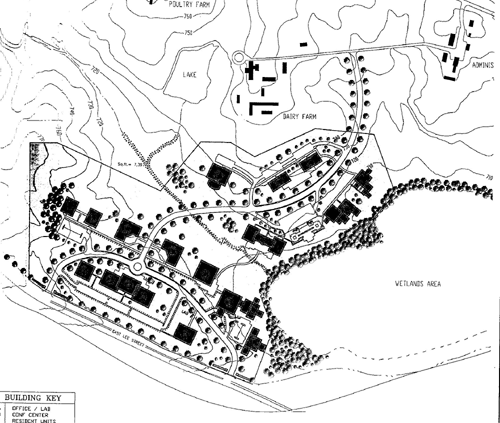 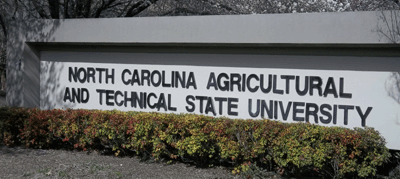 HBCU institution
North Carolina A&T, one of
the state's two land grant
institutions, has programs
through the doctoral level.
Its programs include
engineering, arts and
sciences, agricultural and
environmental sciences,
business and economics,
education, nursing,
technology, and graduates
studies.
“
The expected roles of a
land-grant
institution, is
teaching agriculture and
engineering, and providing
cooperative extension
services”.
NC A&T's 2001 amend
University Master Plan
called for developing 75
acres of land along East
Lee Street targeted to
develop new opportunities
for both research and
education in both the
private and academic arenas
between the University's
technology and agricultural
research and its students,
which didn't include
across-town historical white
UNC Greensboro and its members
of the Greensboro business
community. HBCU institution
North Carolina A&T, one of
the state's two land grant
institutions, has programs
through the doctoral level.
Its programs include
engineering, arts and
sciences, agricultural and
environmental sciences,
business and economics,
education, nursing,
technology, and graduates
studies.
“
The expected roles of a
land-grant
institution, is
teaching agriculture and
engineering, and providing
cooperative extension
services”.
NC A&T's 2001 amend
University Master Plan
called for developing 75
acres of land along East
Lee Street targeted to
develop new opportunities
for both research and
education in both the
private and academic arenas
between the University's
technology and agricultural
research and its students,
which didn't include
across-town historical white
UNC Greensboro and its members
of the Greensboro business
community. |
|
| |
| NCGS
§ 116-198.34. (8b) says in part “The
designation should be based on the
express finding that the institution
has the administrative and fiscal
capacity to create and maintain such
a campus, and provided further, that
the Board of Governors has found
that the creation of the constituent
institution's "Millennial Campus"
will enhance the institution's
research, teaching, and service
missions as well as enhance the
economic development of the region.”
A&T is known for its engineering and
agricultural programs and UNCG’s
background is nursing and the
humanities “.[Its
[UNCG] historically strong programs
in music, education and nursing are
not the kinds of programs that spin
off research and development or
software companies to fuel high tech
economies
[Ken Mayer,
Editorial, UNCG, A&T University will
need to be leaders in the charge for
high-tech industry in the Triad,
Triad Business Journal Nov 9, 1998]
( Ken Mayer is former Chairman UNCG
BOT 2003-2004 & 2004-2005.]
NCA&T and cross-town UNC- G have
different research, teaching, and
service missions. |
| |
Negotiation began in 2002 and
September 2004 NC A&T State
University celebrated the sighing of
Memorandum of Understanding with
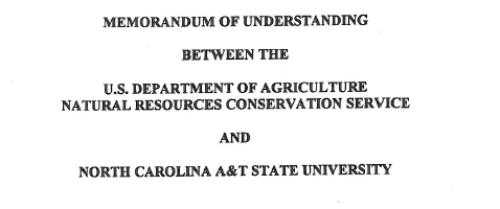 the
U.S. Department of Agriculture
(USDA) with the opening of the
National Resources Conservation
Services Eastern Regional Technology
Center whose service area consisted
of 24 states and the Caribbean area.
The Greensboro Center was also home
to the remote sensing lab. The
Memorandum of Understanding says A&T
has a working farm with modern
facilities and farm equipment. NRCS
will benefit from the use of this
farm by being able to provide
hands-on training to NRCS employees.
NRCS can sponsor field studies that
can serve as the
U.S. Department of Agriculture
(USDA) with the opening of the
National Resources Conservation
Services Eastern Regional Technology
Center whose service area consisted
of 24 states and the Caribbean area.
The Greensboro Center was also home
to the remote sensing lab. The
Memorandum of Understanding says A&T
has a working farm with modern
facilities and farm equipment. NRCS
will benefit from the use of this
farm by being able to provide
hands-on training to NRCS employees.
NRCS can sponsor field studies that
can serve as
 demonstrations
to both NRCS trainees and also local
and regional farmers. A&T
constituents will also benefit from
this type of applied investigation.
Finally, A&T faculty and students
can also benefit academically by
conducting scholarly research and
publishing this information. demonstrations
to both NRCS trainees and also local
and regional farmers. A&T
constituents will also benefit from
this type of applied investigation.
Finally, A&T faculty and students
can also benefit academically by
conducting scholarly research and
publishing this information. |
|
|
 In
2003-04, with the backbone of North
Carolina's industrial economy
Tobacco, Textiles, and Furniture
outsourced, in decline/recession or
outsourced with appropriations for
UNC-System taking an ever increasing
multi-billion dollar bite out of
state's coffers, North Carolina's
Legislature thru House Bill 1264 (HB
1264) direct UNC-BOG and COMMUNITY
COLLEGE SYSTEM to contract a
private consulting firm that had
experience in higher education to
conduct a comprehensive study
(Staying a step ahead) of
the mission and educational program
needs to ensure that the State's
citizens are academically
prepared and equipped for current
job opportunities and jobs of the
future in North Carolina's growing
knowledge economy. In
2003-04, with the backbone of North
Carolina's industrial economy
Tobacco, Textiles, and Furniture
outsourced, in decline/recession or
outsourced with appropriations for
UNC-System taking an ever increasing
multi-billion dollar bite out of
state's coffers, North Carolina's
Legislature thru House Bill 1264 (HB
1264) direct UNC-BOG and COMMUNITY
COLLEGE SYSTEM to contract a
private consulting firm that had
experience in higher education to
conduct a comprehensive study
(Staying a step ahead) of
the mission and educational program
needs to ensure that the State's
citizens are academically
prepared and equipped for current
job opportunities and jobs of the
future in North Carolina's growing
knowledge economy. |
| |
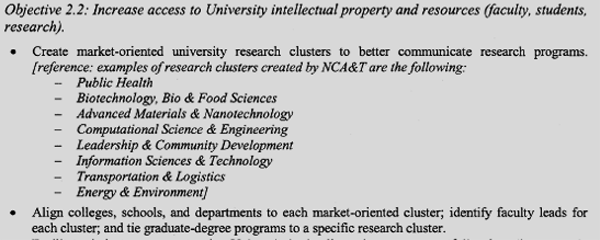 |
Emerging from a legislative
mandated study HB 1264
,Staying a Step Ahead,
to ensure the State's
citizens are academically
prepared and equipped for
current job opportunities
and jobs of the future in
North Carolina's growing
knowledge economy,
explicitly referred to
research clusters created by
HBCU NCA&T |
|
| |
|
HB 1264 (6), says with
regard to the University System,
there shall be special emphasis on
the development of signature
programs for Historically Black
Colleges and Universities and the
University of North Carolina at
Pembroke |
| |
|
Nanotechnology, Nanoscience and
Nanoengineering, should have been
HBCU NCA&T Signature Programs |
| |
|
“Signature programs” have been
defined as those that are
distinctive, that build on
existing strengths, that advance
the institution’s profile, and that
serve regional and/or state economic
transformation needs." |
| |
-
"NCA&T has 12-years of
experience in Nanoscience and
Nanotechnology”
-
“Expertise in nanotechnology may
become a prerequisite for many
scientists and engineers that
support a wide variety of
industries, nano expertise among
the North Carolina science and
engineering workforce may soon
become a competitive advantage
issue for the state.
-
The global market for
nanotechnology products and
services is predicted to
increase by 18-28 percent
annually for the next several
years (BCC Research, Inc.) and
is expected to reach $2.6
trillion by 2014 (Lux Research),
showing the potential for strong
growth in this sector of the
economy
|
| |
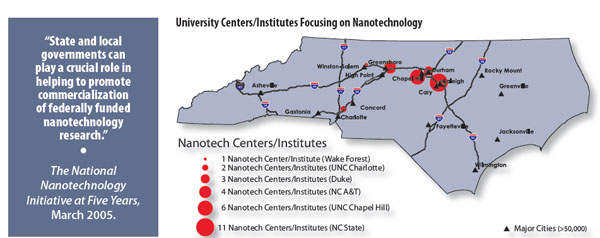 |
|
Historical Black Land Grant
NCA&T was listed as
University focus on
Nanotechnology in
2005. |
| |
|
"We're
Not Following Any Path, We're
Blazing A Trail" |
| |
  NC
A&T is "well known in
areas such as advanced
materials,
nanotechnology,,
computational science,
and says N.
Radhakrishnan, former VP
for research and economic
development at N.C. A&T.
The school also has
significant strengths in
other areas, including
biotechnology, energy
and the environment,
information sciences and
technology, logistics
and transportation
development. NC
A&T is "well known in
areas such as advanced
materials,
nanotechnology,,
computational science,
and says N.
Radhakrishnan, former VP
for research and economic
development at N.C. A&T.
The school also has
significant strengths in
other areas, including
biotechnology, energy
and the environment,
information sciences and
technology, logistics
and transportation
development.
|
 |
|
|
|
All these endeavors are
aligned in eight
research clusters that
bring faculty together
across disciplines to
develop large research
projects. These research
clusters run in parallel
with a number of
multidisciplinary
centers and institutes
at N.C. A&T,
which develop
partnerships with
private and corporate
sponsors, educational
institutions, and
government agencies. |
|
| |
Nanotechnology is
Experimental
NCA&T State University has
been funded at an average
rate of $3-5 million per
year in the area of
nanoscience and
nanotechnology. Most of the
research in nanoengineering
is done in the Center for
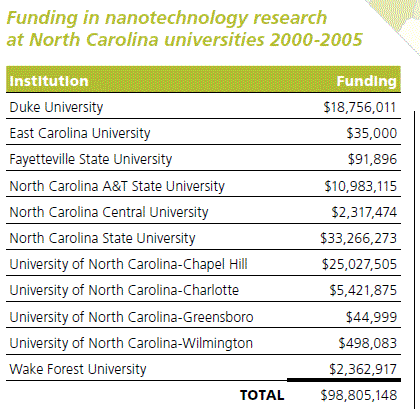 Advanced
Materials and Smart
Structures (CAMSS). Several
Centers and projects are
under CAMSS, including the
NSF Center for Research
Excellence in Science and
Technology (CREST), the DoD
Center for Nanoscience,
Nanomaterials and
Multifunctional Materials
(CNN) for Homeland Security,
the NSF Nanoscale Science
and Engineering Center (NSEC),
the NSF project on US/Europe
Materials Collaboration:
Self-Organized
Nanostructured Thin Films
for Catalysis, the NSF
project on Nanoscale
Interdisciplinary Research
Teams (NIRT), the NSF Major
Research Instrumentation for
Nanoengineering Research,
and the NSF Nanotechnology
Undergraduate Education (NUE)
program. CAMSS also
facilitates many of the
materials research
activities of the
NASA-National Institute for
Aerospace (NIA). In
addition, Advanced
Materials and Smart
Structures (CAMSS). Several
Centers and projects are
under CAMSS, including the
NSF Center for Research
Excellence in Science and
Technology (CREST), the DoD
Center for Nanoscience,
Nanomaterials and
Multifunctional Materials
(CNN) for Homeland Security,
the NSF Nanoscale Science
and Engineering Center (NSEC),
the NSF project on US/Europe
Materials Collaboration:
Self-Organized
Nanostructured Thin Films
for Catalysis, the NSF
project on Nanoscale
Interdisciplinary Research
Teams (NIRT), the NSF Major
Research Instrumentation for
Nanoengineering Research,
and the NSF Nanotechnology
Undergraduate Education (NUE)
program. CAMSS also
facilitates many of the
materials research
activities of the
NASA-National Institute for
Aerospace (NIA). In
addition,
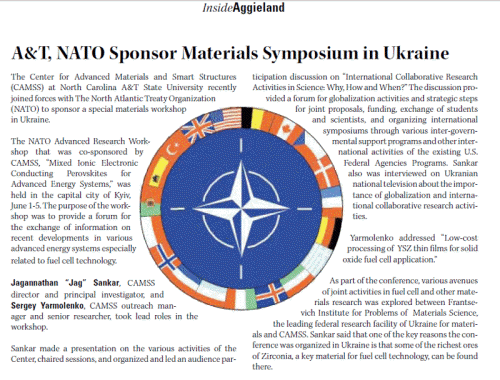 the
Center for Composite
Materials Research (CCMR)
does research in nano-enhanced
composite materials and the
Army Center of Excellence
for Battlefield Capability
Enhancements (Flexible
Displays) does research in
material characterization
and development of novel
displays. the
Center for Composite
Materials Research (CCMR)
does research in nano-enhanced
composite materials and the
Army Center of Excellence
for Battlefield Capability
Enhancements (Flexible
Displays) does research in
material characterization
and development of novel
displays.
NCA&T was 4th in
Nanotechnology Research at
North Carolina Universities
with $11 Million Dollars
between 2000-2005. In
2003 A&T, NATO Sponsor
Material Symposium in
Ukraine. |
|
|
|
|
|
In 2008 NC A&T received an 18 Million dollar
grant for an Engineering Research Center (ECR)
from the National Science foundation. The award
to A&T marked the first time that an HBCU has
been the lead institution of an ERC.
The ERC has
partnerships with pre-college institutions in
North Carolina to involve teachers and students
in engineering; it has partnerships with a broad
range of North Carolina organizations devoted to
entrepreneurship and small business development.
|
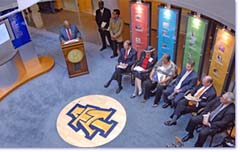 N.C.
A&T Awarded NSF Engineering Research Center N.C.
A&T Awarded NSF Engineering Research Center
Shena Crittendon,
Greensboro – North Carolina A&T State University
has been awarded a grant for an Engineering
Research Center (ERC) from the National Science
Foundation (NSF). Engineering Research Center
grants represent major investments by NSF in
partnership with industry to transform
engineering research and education. The centers
aim to produce innovative technologies and
engineering graduates to significantly enhance
the competitiveness of the U.S. economy. Award
funding has been approved at $18 million for the
initial five years, with a potential duration of
10 years.
The NSF ERC
for Revolutionizing Metallic Biomaterials at A&T
will conduct research in the areas of biomedical
engineering and nano-bio applications and is in
partnership with the Universities of Cincinnati
and Pittsburgh. It also has a global technical
partner in Germany’s Hannover School of Medicine
and a global cultural and outreach partner in
the Indian Institute of Technology, Madras,
India. California State University at Los
Angeles will serve as an outreach partner in the
USA. The ERC has partnerships with
pre-college institutions in North Carolina to
involve teachers and students in engineering; it
has partnerships with a broad range of North
Carolina organizations devoted to
entrepreneurship and small business development.
|
|
"With the millions of federal dollars flowing to
this center (NSF ERC), what [ we] can do to
increase the economic opportunities in Guilford
County, the Triad and in the state of North
Carolina is truly phenomenal," said Erskine
Bowles , president of the UNC system. [A&T lands
prized NSF center][31].
|
A&T’s ERC will be led by Dr. Jagannathan Sankar,
professor of engineering. Dr. William Wagner
from the University of Pittsburgh and Dr. Mark
Schulz from the University of Cincinnati will
serve as co-directors. Dr. Devdas Pai, professor
of engineering at A&T, will lead educational
aspects of the ERC. The ERC research will focus
on three engineered systems: Craniofacial and
Orthopedic Applications; Cardiovascular Devices;
and Responsive Biosensors for Implants. The ERC
will introduce new metallic materials, devices,
and systems that have the potential to exhibit
all the
necessary attributes of an ideal foundation or
“scaffold” and that promise to completely
transform the field of regenerative medicine.
Similarly, innovative metallic materials will be
introduced as stents in the treatment of
cardiovascular problems. Nano sensors will be
developed to study the efficacy of these devices
as part of this research. More than eight
companies will be associated with the ERC to
provide input for the direction of research as
well as a conduit to transfer the technology to
the real world. NC A&T will also start a new
department of bioengineering in conjunction with
this ERC. The department will offer BS, Masters
and PhD degrees |
|
|
|
|
|
|
The National Center for
Educational Statistics (NCES) responsible for collecting
and presenting statistical data and information for the
nation; classifies Nanoscience and Nanoengineering as
Nanotechnology CIP 15.1601: Engineering technologies and
Engineering related fields. |
|
|
|
Nanotechnology. Definition: A program that prepares
individuals to apply mathematical, scientific, and
engineering principles and technical skills to
manipulate matter at the atomic and molecular level (in
the range of 1-100 nanometers) and to design, fabricate,
and integrate nanoscale structures, devices, and
systems. Includes instruction in materials science,
thermodynamics, nanomaterials, Nano electronics, and
nano/micro device fabrication and testing. [https://nces.ed.gov/search/?q=nano+science]:
|
|
|
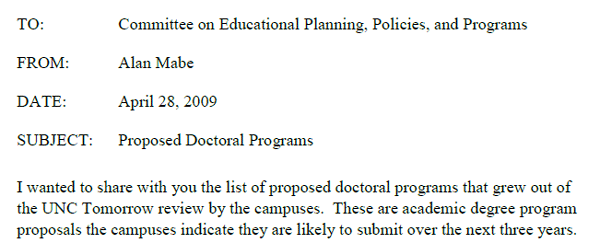
|
Dr. Alan Mabe Memorandum dated April 28, 2009 to Ed
Planning, Ph.D. proposal degree NC A&T
Nanoscience and Material Science and UNC-G Nanoscience
clearly indicated NC A&T Nanoscience and
Material Science (Nanoengineering).
|
 |
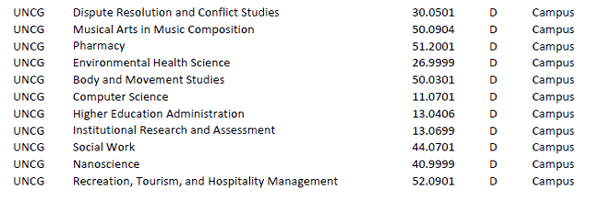 |
|
|
|
 |
|
PCG/UNC-NCCCS/UNC Interim
report
3.doc/RB.SP.PC.CR.ATPCC.1/CC.14/10May05
|
|
| |
Historical black North Carolina A&T,
as one of the state's two land grant
institutions, has programs through
the doctoral level. Its programs
include engineering, arts and
sciences, agricultural and
environmental sciences, business and
economics, education, nursing,
technology, and graduates studies.

“The expected roles of a land-grant
institution, is teaching agriculture
and engineering, and providing
cooperative extension services” . |
|
|
The UNC Policy Manual 400.1.1.1[G]
 |
A degree program is a program of study in a discipline
specialty that leads to a degree in that distinct
specialty area at a particular level of instruction.
As a general rule, in order to be considered for degree
program status, a course of study should require at
least 27 semester hours in the proposed program area at
the undergraduate level; at least half the number of
hours required for the degree at the master’s level; and
at least 21 hours in the proposed program area at the
doctoral level. [Adopted 05/06/09] |
| |
|
UNC
Board of Governors January 2007
authorized UNC Charlotte, which has
an Engineering School, to offer a
Ph.D. in Nanoscale Science.
Offering Nanoscale Science
was not a Substantial Change as
defined by the SACS for UNC
Charlotte. Nov. 2012 UNC Board of
Governors authorized a Master’s in
Nanoengineering to Land Grant
Institution NC State, which has an
Engineering School. Offering a MS in
Nanoengineering was not a
Substantial Change as defined by the
SACS for NC State.
|
| |
| Historical
black North Carolina A&T, as one of
the state's two land grant
institutions, has programs through
the doctoral level. Its programs
include engineering, arts and
sciences, agricultural and
environmental sciences, business and
economics, education, nursing,
technology, and graduates studies.
“The expected roles of a land-grant
institution, is teaching agriculture
and engineering, and providing
cooperative extension services” .
|
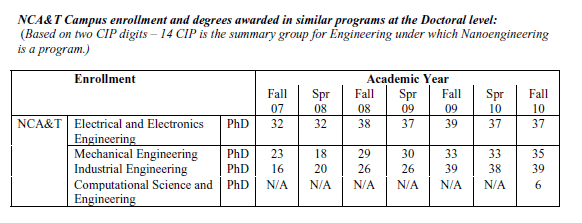 |
|
Consistent with other
engineering schools in the UNC
System offering Nanoscience and
Nanoengineering programs
are not Substantial
Changes as defined by the SACS and
consistent with the
education, curricular, mission and
goals of NC A&T State University. |
 |
| [
former UNC] President Molly Broad,
.... shared that by 2020, 70 percent
of the World's Scientist will live
and work in Asia, unless the country
does some different kinds of things.
She said that North Carolina A&T is
in a position to educated and
graduate world-class educated and
graduate world-class scientists
because of initiatives scientists
because of initiatives underway
within our science and technology
areas, and now is the time for the
university to step up to the plate
to meet the challenges ahead",
alleged Dr. Speight-Buford, NC A&T
Fourth Regular Board of Trustees
meeting April 20, 2005 |
|
|
 the
U.S. Department of Agriculture
(USDA) with the opening of the
National Resources Conservation
Services Eastern Regional Technology
Center whose service area consisted
of 24 states and the Caribbean area.
The Greensboro Center was also home
to the remote sensing lab. The
Memorandum of Understanding says A&T
has a working farm with modern
facilities and farm equipment. NRCS
will benefit from the use of this
farm by being able to provide
hands-on training to NRCS employees.
NRCS can sponsor field studies that
can serve as
the
U.S. Department of Agriculture
(USDA) with the opening of the
National Resources Conservation
Services Eastern Regional Technology
Center whose service area consisted
of 24 states and the Caribbean area.
The Greensboro Center was also home
to the remote sensing lab. The
Memorandum of Understanding says A&T
has a working farm with modern
facilities and farm equipment. NRCS
will benefit from the use of this
farm by being able to provide
hands-on training to NRCS employees.
NRCS can sponsor field studies that
can serve as
 demonstrations
to both NRCS trainees and also local
and regional farmers. A&T
constituents will also benefit from
this type of applied investigation.
Finally, A&T faculty and students
can also benefit academically by
conducting scholarly research and
publishing this information.
demonstrations
to both NRCS trainees and also local
and regional farmers. A&T
constituents will also benefit from
this type of applied investigation.
Finally, A&T faculty and students
can also benefit academically by
conducting scholarly research and
publishing this information. In
2003-04, with the backbone of North
Carolina's industrial economy
Tobacco, Textiles, and Furniture
outsourced, in decline/recession or
outsourced with appropriations for
UNC-System taking an ever increasing
multi-billion dollar bite out of
state's coffers, North Carolina's
Legislature thru House Bill 1264 (HB
1264) direct UNC-BOG and COMMUNITY
COLLEGE SYSTEM to contract a
private consulting firm that had
experience in higher education to
conduct a comprehensive study
(Staying a step ahead) of
the mission and educational program
needs to ensure that the State's
citizens are academically
prepared and equipped for current
job opportunities and jobs of the
future in North Carolina's growing
knowledge economy.
In
2003-04, with the backbone of North
Carolina's industrial economy
Tobacco, Textiles, and Furniture
outsourced, in decline/recession or
outsourced with appropriations for
UNC-System taking an ever increasing
multi-billion dollar bite out of
state's coffers, North Carolina's
Legislature thru House Bill 1264 (HB
1264) direct UNC-BOG and COMMUNITY
COLLEGE SYSTEM to contract a
private consulting firm that had
experience in higher education to
conduct a comprehensive study
(Staying a step ahead) of
the mission and educational program
needs to ensure that the State's
citizens are academically
prepared and equipped for current
job opportunities and jobs of the
future in North Carolina's growing
knowledge economy.







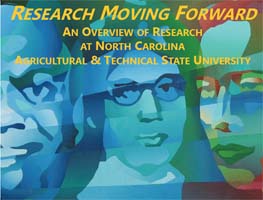


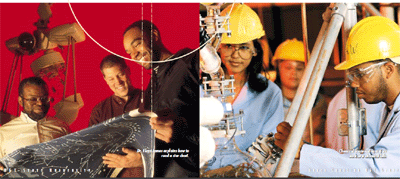
 Advanced
Materials and Smart
Structures (CAMSS). Several
Centers and projects are
under CAMSS, including the
NSF Center for Research
Excellence in Science and
Technology (CREST), the DoD
Center for Nanoscience,
Nanomaterials and
Multifunctional Materials
(CNN) for Homeland Security,
the NSF Nanoscale Science
and Engineering Center (NSEC),
the NSF project on US/Europe
Materials Collaboration:
Self-Organized
Nanostructured Thin Films
for Catalysis, the NSF
project on Nanoscale
Interdisciplinary Research
Teams (NIRT), the NSF Major
Research Instrumentation for
Nanoengineering Research,
and the NSF Nanotechnology
Undergraduate Education (NUE)
program. CAMSS also
facilitates many of the
materials research
activities of the
NASA-National Institute for
Aerospace (NIA). In
addition,
Advanced
Materials and Smart
Structures (CAMSS). Several
Centers and projects are
under CAMSS, including the
NSF Center for Research
Excellence in Science and
Technology (CREST), the DoD
Center for Nanoscience,
Nanomaterials and
Multifunctional Materials
(CNN) for Homeland Security,
the NSF Nanoscale Science
and Engineering Center (NSEC),
the NSF project on US/Europe
Materials Collaboration:
Self-Organized
Nanostructured Thin Films
for Catalysis, the NSF
project on Nanoscale
Interdisciplinary Research
Teams (NIRT), the NSF Major
Research Instrumentation for
Nanoengineering Research,
and the NSF Nanotechnology
Undergraduate Education (NUE)
program. CAMSS also
facilitates many of the
materials research
activities of the
NASA-National Institute for
Aerospace (NIA). In
addition,

 N.C.
A&T Awarded NSF Engineering Research Center
N.C.
A&T Awarded NSF Engineering Research Center



